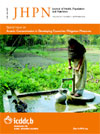
|
The Journal of Health, Population and Nutrition
icddr,b
ISSN: 1606-0997
EISSN: 1606-0997
Vol. 36, No. 1, 2017, pp. 1-14
|
 Bioline Code: hn17045
Bioline Code: hn17045
Full paper language: English
Document type: Research Article
Document available free of charge
|
|
|
The Journal of Health, Population and Nutrition, Vol. 36, No. 1, 2017, pp. 1-14
| en |
Factors influencing contraceptive use and non-use among women of advanced reproductive age in Nigeria
Solanke, Bola Lukman
Abstract
Background: Factors influencing contraceptive use and non-use among women of advanced reproductive age
have been insufficiently researched in Nigeria. This study examines factors influencing contraceptive use and
non-use among women of advanced reproductive age in Nigeria.
Methods: Secondary data were pooled and extracted from 2008 and 2013 Nigeria Demographic and Health
Surveys (NDHS). The weighted sample size was 14,450 women of advanced reproductive age. The dependent
variable was current contraceptive use. The explanatory variables were selected socio-demographic characteristics
and three control variables. Analyses were performed using Stata version 12. Multinomial logistic regression was
applied in four models.
Results: Majority of the respondents are not using any method of contraceptive; the expected risk of using modern
contraceptive relative to traditional method reduces by a factor of 0.676 for multiparous women (rrr = 0.676; CI: 0.464–0.985); the expected risk of using modern contraceptive relative to traditional method reduces by a factor of 0.611 for
women who want more children (rrr = 0.611; CI: 0.493–0.757); the relative risk for using modern contraceptive relative
to traditional method increases by a factor of 1.637 as maternal education reaches secondary education (rrr = 1.637;
CI: 1.173–2.285); the relative risk for using modern contraceptive relative to traditional method increases by a factor of
1.726 for women in richest households (rrr = 1.726; CI: 1.038–2.871); and the expected risk of using modern contraceptive
relative to traditional method increases by a factor of 1.250 for southern women (rrr = 1.250; CI: 1.200–1.818).
Conclusions: Socio-demographic characteristics exert more influence on non-use than modern contraceptive use.
The scope, content and coverage of existing BCC messages should be extended to cover the contraceptive
needs and challenges of women of advanced reproductive age in the country.
Keywords
Modern contraceptive; Advanced reproductive age; Contraceptive use; Contraceptive non-use; Traditional method; Women; Nigeria
|
| |
© Copyright 2017 - The Author(s)
Alternative site location: http://www.jhpn.net
|
|
